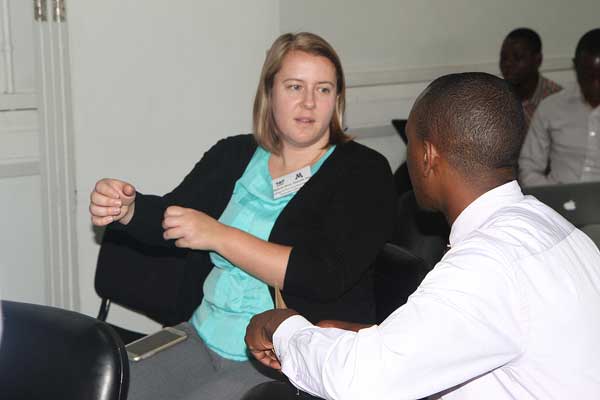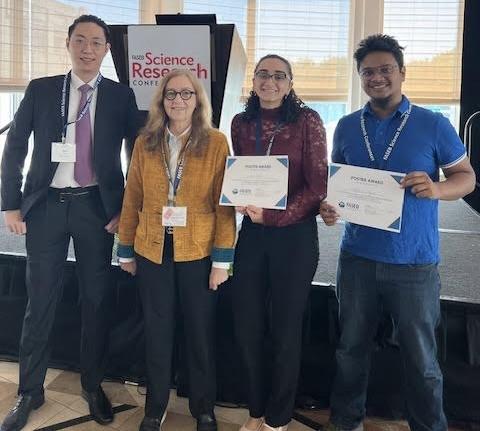New funding awarded for HIV-related research
November 11, 2024
Erin Wilson

Dr. Melanie Nicol talking at a conference in Uganda
Dr. Melanie Nicol, associate professor and director of graduate studies in the Department of Experimental and Clinical Pharmacology (ECP), received a new award of $3 million across the next five years from the National Institutes of Health (NIH). The award will give her the opportunity to further explore drug concentrations in the brain tissue of individuals with HIV-associated opportunistic infections.
Opportunistic infections take advantage of weaker immune systems. People with healthy, functioning immune systems can fight off pathogens. But particularly in cases of advanced and untreated HIV, common infections can escalate into deadly diseases in the brain, such as meningitis.
“Those are among the most deadly of the opportunistic infections, because anytime the brain is involved, it's generally bad. It's [a leading cause] for a lot of the people who are still dying from HIV,” Nicol said. “Especially in Africa and parts of the world where HIV is an even bigger problem than it is in the U.S., it is these brain-related infections that are killing a lot of people.”
Two of the primary diseases Nicol’s research focuses on are cryptococcus, a fungal infection, and the bacterial infection tuberculosis, both of which can spread to the brain and cause variations of meningitis. Her research employs pharmacokinetics and pharmacodynamics, which examine the relationship between drug exposure and drug effect, to measure how effectively a pathogen is removed from the brain. Understanding how HIV drug treatments access different tissue compartments in the brain is key to the search for a cure. Since it's hard to access the brain in living people, this is often done using cerebrospinal fluid, which is tapped during treatment for meningitis to relieve swelling, Nicol said.
“The other part of my grant is to study an autopsy cohort. Because these diseases are so deadly, there are a number of people who, even though they're on treatment, still pass away,” Nicol said. “We are actually doing post-mortems on those individuals, looking in different parts of their brain to see where the drug is going. Is it concentrating in certain areas more than others? Where is the pathogen? Where is the fungus going? Where is the [tuberculosis] going? Where is the HIV going, and is it not the same place?”
When Nicol joined the college in 2014, she was sent to Kampala, Uganda, to seek out pharmacy collaborations within a research site with a long-standing partnership with the University of Minnesota. There, she met a research group studying meningitis and opportunistic infections, with whom she has now collaborated for the past 10 years.
“We had this overlap of interest in understanding how drugs get in and out of tissues; they were interested in the fungus, I was interested in HIV,” Nicol said. “As I worked with them more, they didn't really have a pharmacology person on their team, so I started filling in that role and becoming more interested in understanding drug exposure of antifungal drugs. Now we've started doing more [tuberculosis] work as well.”
Nicol’s pilot grants allowed them to hire and train Ugandan pathologists to perform autopsies, fund the infrastructure for collecting and storing the tissues, and gather pilot data. The next step is to obtain larger sample sizes and assay capacity— meaning the analytical procedure of measuring the presence and activity of a drug.
“We're able to measure a lot of different drugs in a lot of different kinds of tissues, so we have assays to measure it in blood, in cerebrospinal fluid, and in actual brain tissue. We're hoping to start measuring drugs in potentially other tissues that are really important for infection, like the eyes, or other organs like the liver and kidney,” Nicol said. “To do that you have to have a robust assay method and validation, which can be quite costly actually, to have validated assays.”
The overarching goal is to develop a regimen of drugs that will lower mortality rates for these often fatal opportunistic infections by more thoroughly understanding the connection between the amount of the drug permeating the brain and clearing the infection faster. Part of that is also done through pharmacometric modeling— in other words, “using statistics and our conceptual understanding of drug distribution to make better predictions,” Nicol said.
“We can't go around sampling brain tissue from everyone, so how do we make better predictions with the available data that we have on drug characteristics?” Nicol said. “What are the things that can contribute to variability between this person and this person? Does that explain differences in drug exposure? So really, we’re just looking for better models to explain this.”
This all ties into one of Nicol’s passions, which is giving more students the opportunity to get involved in global health research.
“Now I have some support, so I can help pay for students to be trained under this grant, even if they do it all from here,” Nicol said. “But then, hopefully, maybe even help them travel to Uganda someday and see the research that's going on there first hand. That's been a really valuable experience for me, so the chance to pass that on to future trainees is something that's important to me.”


